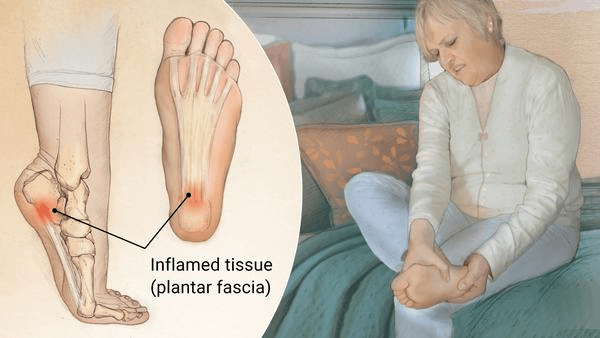“Plantar fasciitis (PLAN-tur fas-e-I-tis) is one of the most common causes of heel pain. It involves inflammation of a thick band of tissue that runs across the bottom of your foot and connects your heel bone to your toes (plantar fascia). Plantar fasciitis is more common in runners. People who are overweight and those who wear shoes with inadequate arch support also have an increased risk of plantar fasciitis” (Mayo Clinic, 2019)
What causes plantar fasciitis?
“Your plantar fascia is in the shape of a bowstring, supporting the arch of your foot and absorbing shock when you walk. If tension and stress on this bowstring become too great, small tears can occur in the fascia. Repeated stretching and tearing can irritate or inflame the fascia, although the cause remains unclear in many cases of plantar fasciitis” (Mayo Clinic, 2019). While the cause remains unclear, there are a handful of risk factors that could make a patient more likely to obtain plantar fasciitis. These risk factors include age (40-60 years), certain types of exercise (ballet dancing, long-distance running, etc.), foot mechanics (abnormal walking pattern, height of foot arch, etc.), obesity, and occupations that keep you on your feet (teachers, servers, mail carrier etc.) (Mayo Clinic, 2019).

What are the symptoms of plantar fasciitis?
“Plantar fasciitis typically causes a stabbing pain in the bottom of your foot near the heel. The pain is usually the worst with the first few steps after awakening, although it can also be triggered by long periods of standing or when you get up after sitting. The pain is usually worse after exercise, not during it” (Mayo Clinic, 2019).
How does one treat plantar fasciitis?
“Most people who have plantar fasciitis recover in several months with conservative treatment, including resting, icing the painful area and stretching. Your physical therapist or doctor might recommend that you wear a splint that stretches your calf and the arch of your foot while you sleep. This holds the plantar fascia and Achilles tendon in a lengthened position overnight to promote stretching.

Your doctor might prescribe off-the-shelf or custom-fitted arch supports (orthotics) to help distribute pressure to your feet more evenly” (Mayo Clinic, 2019) Over the counter pain medications, such as Tylenol or Advil, may also be taken to reduce pain and inflammation. A licensed doctor may perform ultrasound therapy, electric muscle stimulation, or manual/trigger point therapy to alleviate pain and reduce inflammation of the foot/heel. In severe cases, a patient may get a steroid injection for temporary pain relief. Very rarely do plantar fasciitis patients need surgery, however “it is generally an option only when the pain is severe and other treatments have failed. It can be done as an open procedure or through a small incision with local anesthesia” (Mayo Clinic, 2019).
Work Cited
Plantar fasciitis. (2019, December 11). Retrieved July 14, 2020, from https://www.mayoclinic.org/diseases-conditions/plantar-fasciitis/symptoms-causes/syc-20354846
